Build it Back Greenbushfires
In the Media
Building back green in Chelmer
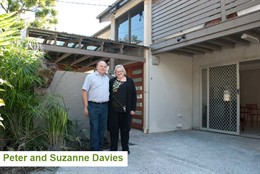 In the leafy Brisbane suburb of Chelmer, Peter and
Suzanne Davies are busy rebuilding their beloved home after it was
left devasted by the Queensland floods of January 2011. They are
not alone. All over the state, people are still putting the pieces
of their lives back together.
In the leafy Brisbane suburb of Chelmer, Peter and
Suzanne Davies are busy rebuilding their beloved home after it was
left devasted by the Queensland floods of January 2011. They are
not alone. All over the state, people are still putting the pieces
of their lives back together.
While a get-back-on-your-feet approach has underpinned many rebuilding projects, the Davies' house in Chelmer stands out as a shining example of 'building back green' with a range of resilient and sustainable features.
"We were always interested in [building back green] but couldn't afford it until it became more mainstream and the prices came down," Peter and Suzanne said.
"We love the idea that we are producing a lot of our own electricity and hot water, that we are using tank water for our toilets and gardens [and] that we are saving water."
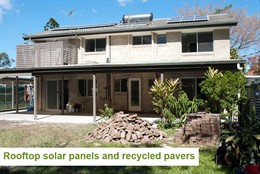
The house has integrated resilient building principles to enable to it to better withstand another flood, including a prototype modular kitchen that can be removed given 24 hours notice and a specially conceived electrical wiring system that separates the upper and lower levels. This will allow the owners to continue living upstairs and generating power from roof-mounted solar panels should a future flood again disrupt the lower floor occupancy.
Inspired by the Build it Back Green - QLD workshop
On 17 March 2011, following Queensland's summer of devastating weather, Green Cross Australia hosted a Build it Back Green - Queensland workshop and it became the catalyst for the house's rebuild. Due to the combination of principles of sustainability and resilience, Build it Back Green provides a basis for people to build strong and environmentally responsible housing that is specific to current weather dangers as well as those predicted to threaten communities due to future climate change impacts. It is a concept that has been used in the rebuilding of New Orleans, Greensburg in Kansas and the communities affected by the Black Saturday bushfires.
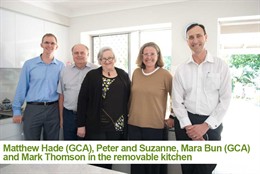
Jeremy Mansfield, Corportate Volunteer and Green Cross Australia's Head of Development, presented at the workshop which was attended by builders, designers, insurance companies, home owners and other stakeholders. The workshop was intended to help Queenslanders bounce back stronger after the State's devastating natural disaster season.
"Build it Back Green is a project run by Green Cross Australia. It has successfully helped Victorians rebuild sustainably & with resilience after the Black Saturday bushfires of 2009, " Jeremy said.
"The aim of the workshop was to catalyse partnerships between key stakeholders who would be crucial to the flood rebuilding effort. I invited my colleague Mark Thomson to attend the event."
The Rebuild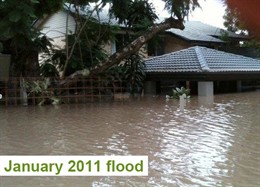
Flooded property rebuilds require particular expertise including sterilisation and extensive drying of effected building elements. Mark Thompson, owner and manager of Eco Effective Solutions (www.ecoeffective.com.au) was impressed with the diverse range of issues covered in the Build it Back Green - Queensland workshop and the knowledge and contacts gained from this contributed to the Chelmer rebuild approach. Mark Thomson, explains:
"I heard that the Davies' had put out a request for help looking for design ideas following their realisation that much of the house would need rebuilding. They didn't see the sense in building back what they had if it didn't suit their current needs.
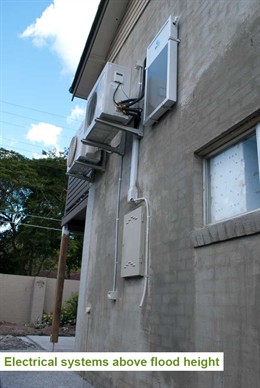
I sat down with the homeowners and we came up with a range of practical improvements."
"For instance, upstairs and downstairs wiring was separated to allow part of the house to be operational should a flood threaten again. The kitchen was designed to be deconstructed and removed with that in mind as well," he said.
It was initially recommended by the insurance company that if substantial changes were required, an insurance payout could be arranged. Upon checking the cost of an insurance payout compared to the proposed rebuild, it became evident that working with the allocated insurance building contractors, greater value for money would be achieved in the rebuild process.
Mark consulted Suncorp and the Davies' insurer to outline a proposed Build Back Green rebuild approach and both were receptive to the idea.
The building contractor allocated for the rebuild was Priority One, an experienced residential builder. Project manager, David Kelly of Priority One and Alain Steiger from Germancraft Kitchens were to become key collaborators in the rebuild as both saw the potential of the 'build it back green' concept and embraced the ideas with enthusiasm.
"Build it Back Green has been invaluable in the restoration of our flooded house. Thanks to the inspiration it gave it Mark, it helped us transform our home into a more sustainable and resilient building after the floods," home owner Suzanne Davies said.
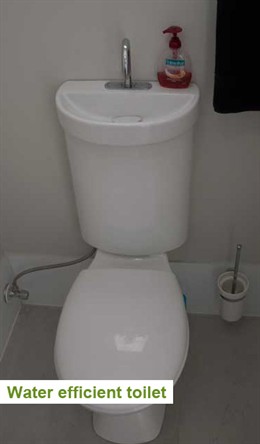
Resilient materials and finishes were used in the rebuilt house to withstand future floods, including tiled floors, elevated power sockets and the positioning of the solar inverter and air-conditioning systems above historical flooding levels.
Other improvements addressed the environmental impact of the building, such as low-toxic paints, a solar hot water system to replace the old electric heater, tank plumbing to allow rainwater to flush toilets and insulation to reduce the house's energy requirements for heating and cooling.
In regards to design, the entrance was rebuilt in order to improve airflow, more water tanks were installed and the house even has a toilet that incorporates a basin into the top of the cistern so that not only do you use tank water to clean your hands but this water then fills us the cistern, a fantastic and resourceful use of precious natural commodities.
"The home is now much more resilient - able to cope better with what nature can throw at it. Any way you look at it, building back green just makes a lot of sense," sustainable architect Mark Thomson said.
Making a difference
Mark Thomson's masterplanning approach to design challenged the Davies to consider if and how they would be living in the house in their later years of life. Design for resilience requires social - as well as environmental - consideration.
The key lesson we can all take away from the Davies' experience is that rebuilding resiliently and sustainably after disaster is certainly achievable.
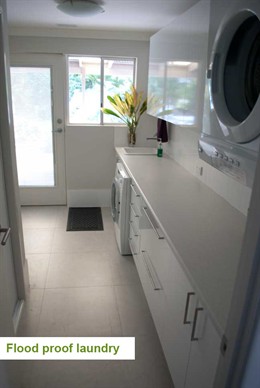
"This is a great example of Green Cross Australia
inspiring Australians to take action, rebuilding
sustainably and increasing resiliece after
natural disasters," Jeremy said.
Furthermore, people who live in disaster prone areas who undertake rebuilding of this kind should be able to negotiate reduced insurance premiums.
"Now that we've proven that many of the Build it Back Green initiatives can be achieved at minimal cost, we are determined to challenge insurance companies on how they can let rebuilding occur without taking more consideration of environmental issues," Mark said.
"Many builders are happy to provide more resilient solutions, however clear objectives must be agreed by all stakeholders."
Peter and Suzanne Davies advise other home owners that when they are in the same situation, at the end of the day, "it boils down to wanting to do the best for the planet in the circumstances and feeling at peace with your decisions," Suzanne said.
"We hope that our story is a source of inspiration for others who face the same situation in the future and leads to more proactive, sustainable ways of looking at building in flood-prone areas at an insitituational and governmental level," she said.
The rebuilding of this home is a model for social empowerment through resilience. It illustrates that simple and proactive steps can be taken by everyone to ensure that you, your family and your community have sustainable foundations in place to weather any storm.
We are looking forward to hearing how Peter and Suzanne's home develops and stay tuned for future updates.
This project was recently featured on ABC's By Design. Read more about Build it Back Queensland here.
